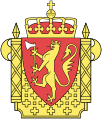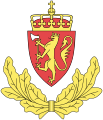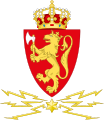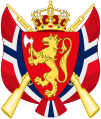Coat of arms of Norway facts for kids
Quick facts for kids Coat of arms of Norway |
|
|---|---|

Greater (royal) version
|
|
| Versions | |

Lesser (royal) version, design by Eilif Peterssen 1905
|
|

State coat of arms, design by Sverre Morken, 1992
|
|

The banner of arms, which serves as royal standard
|
|

The king's tabard and equestrian arms, depicted in the 15th-c. armorial of the Order of the Golden Fleece and various royal seals
|
|
| Armiger | Harald V, King of Norway |
| Adopted | 1280 or earlier |
| Blazon | Gules, a lion rampant Or, crowned and bearing an axe Or with blade Argent |
| Order(s) | Order of St. Olav |
| Other elements | Mantle |
The coat of arms of Norway is a very old and important symbol for the country. It belongs to King Harald V of Norway and represents both the King and the nation of Norway. It shows a golden lion standing on a red background. The lion wears a golden crown and holds a golden axe with a silver blade.
This special symbol is used by the King, the government, the Parliament, and the Supreme Court. These are the three main parts of Norway's government, as set out in the Constitution. Many other official groups, like county governors and courts, also use it.
Since 1905, there have been two main versions: a fancy one for the King and a simpler one for the government. The design of the coat of arms is also used on the King's flag, called the Royal Standard.
Some old lands, cities, groups, and even families have been allowed to use parts of the coat of arms. But it is against the law to use it unless you have official permission.
History of the Norwegian Coat of Arms
The coat of arms started in the 1200s. At first, it was just a golden lion on a red shield. The silver axe was added later in that century. The axe is a symbol of Saint Olav, who was known as the "Eternal King of Norway." Adding the axe showed that the current king was the rightful leader, following in Saint Olav's footsteps.
The lion and axe symbol was first used by the Sverre dynasty of kings. When that family line ended in 1319, the coat of arms became part of the symbols for later kings who ruled Norway, often combined with symbols from other kingdoms.
By the late 1400s, the Sverre coat of arms was seen as the main symbol for the Norwegian monarchy. It was used on coins and official seals even when Norway was united with Denmark (1523–1814) and later with Sweden (1814–1905). Its history makes it one of the oldest national symbols still used today.
From about 1500 to 1844, the axe in the design often looked like a curved pollaxe or halberd. But in 1844, King Oscar I of Sweden changed it back to look more like a medieval battle-axe.
After Norway became fully independent from Sweden in 1905, a new design was made by artist Eilif Peterssen. This design looked more like the old medieval shield and lion. Peterssen's design was used until 1937, when it was changed again by Hallvard Trætteberg to be simpler. However, Peterssen's design is still used for the Royal Standard and the King's own coat of arms.
How the Coat of Arms is Used Today
A rule from 1927 says that the national coat of arms can only be used by government groups when they are doing official work. This includes the Royal Court, the government, the parliament, and the courts. The Ministry of Foreign Affairs handles all matters about the coat of arms. The national coat of arms usually has just a crown on top of the shield.
The King's royal coat of arms is a bit different. It has the shield on a purple cloth (called a mantle) lined with ermine (a type of fur), with a royal crown on top. The shield is also surrounded by the collar of the Royal Order of St. Olav, which is a special honor.
The Royal Standard of Norway is simply the Norwegian coat of arms shown on a flag.
Many Norwegian organizations use the royal arms as part of their own symbols:
-
Air Force pilots
-
Telegraph Administration (1924)
Early History of the Lion and Axe
Historians believe the design of the coat of arms comes from the House of Sverre royal family. Some think King Sverre of Norway, who ruled from 1184 to 1202, might have had a lion in his coat of arms. However, there is no clear proof of this.
A famous writer named Snorre Sturlason said that a golden lion on a red background was used by King Magnus III as early as 1103. But experts like Gustav Storm later said this was probably not true. It is possible Snorre, who wrote for the King, gave King Sverre's coat of arms to earlier kings.
The first clear sign of a lion on a coat of arms in Norway is from a seal of Earl Skule Bårdsson in 1225. He was related to the royal family.
King Haakon Haakonson the Old also had a lion in his seal, shown lying near his feet. A royal coat of arms with a lion finally appeared on the seal of Haakon Haakonson the Young in 1250.
The very first time the lion is shown holding an axe is in a seal of King Eric II from 1285.
Approximately in 1280, either King Magnus VI or his son Eric Magnuson's guardians added a golden crown to the lion and a silver axe in its paws. As mentioned, the axe was a symbol of Saint Olav. This addition showed that the King was the rightful heir of the "Eternal King of Norway."
Medieval Seals Showing the Coat of Arms
| Seal | Bearer | Description |
|---|---|---|
 |
Earl Skule | Used in 1225. |
 |
King Haakon the Old | Seal from 1247/1248, showing a small lion at the King's feet. |
 |
King Haakon the Old | The back of the seal above. |
 |
King Haakon the Young | Seal from 1250. |
 |
King Eric II | Seal from 1298. The lion on the shield does not have an axe, but the one on the horse's blanket does. |
Seals with the Axe Added
| Seal | Bearer | Description |
|---|---|---|
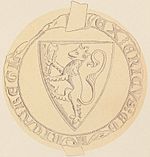 |
King Eric II | Seal from 1285. |
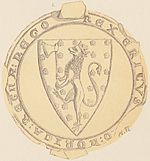 |
King Eric II | Seal from 1283 and 1285. This version has flowers on the shield. |
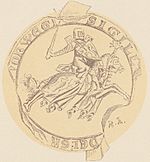 |
Duke Haakon Magnusson | Seal from between 1292 and 1298. |
 |
King Haakon V | Seal from between 1300 and 1302. |
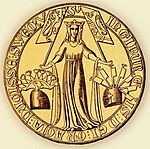 |
Duchess Ingeborg | Seal from 1318. |
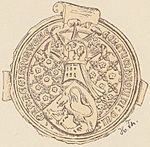 |
King Haakon VI | Seal on documents between 1358 and 1369. |
 |
King Haakon VI | Seal on documents between 1358 and 1376. |
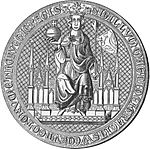 |
King Magnus VII (ruled 1319–1343) | |
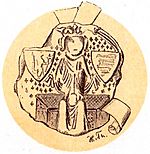 |
King Olav IV | Seal from 1382 and 1384. |
 |
King Haakon V | |
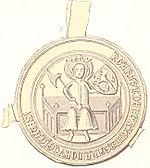 |
Queen Margaret | Her seal as Norway's ruler. She holds both an Olav axe and the Royal Coat of Arms, showing her power. |
Coat of Arms During Unions
When King Haakon V of Norway died in 1319, the Sverre royal family line ended. The throne and the Royal Coat of Arms went to Magnus VII, who was King Haakon V's grandson.
After this, Norway was often united with other countries under one ruler. When a king ruled several countries, he would combine their coats of arms. At first, Norway's coat of arms was very important because Norway was a hereditary kingdom (meaning the crown passed down in the family).
However, over time, Norway's coat of arms was sometimes placed in a less important spot, with Denmark's symbol taking the main position.
Combined Arms from 1450 to 1814
In 1450, Christian of Oldenburg became King of Norway. He was already King of Denmark and later became King of Sweden. Norway's coat of arms was placed in different parts of the combined shield. This continued until 1814.
The kings during this time used coats of arms that showed their rule over many different kingdoms, peoples, and lands.
| Arms | Bearer | Description |
|---|---|---|
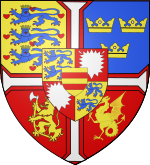 |
King Christian I | A modern picture of the coat of arms. |
 |
King Christian I King John (Hans) King Christian II |
From 1460 to 1523. A modern picture of the coat of arms. |
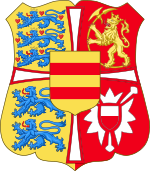 |
King Frederick I | A modern picture of the coat of arms. |
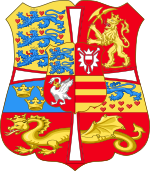 |
King Christian III | A modern picture of the coat of arms. |
 |
King Frederick II King Christian IV King Frederick III King Christian V |
A modern picture of the coat of arms. |
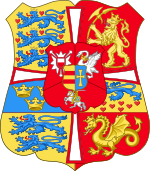 |
King Frederick IV King Christian VI King Frederick V King Christian VII King Frederick VI |
After he stopped being king in 1814, Frederick VI kept Norway's coat of arms until 1819. A modern picture of the coat of arms. |
Combined Arms from 1814 to 1905
On November 4, 1814, the Norwegian Storting (Parliament) chose King Charles XIII of Sweden to be King of Norway. This union with Sweden lasted until 1905.
The combined coats of arms used during this union were not widely used in Norway itself. Only the lion coat of arms of Norway appeared on Norwegian coins and official documents signed by the King as the ruler of Norway.
The union arms introduced by King Oscar I in 1844 were used by the royal family and for things that involved both countries. But in Norway, these union arms were never used on coins or most official papers.
| Union Arms (not used widely in Norway) | ||
|---|---|---|
| Arms | Year | Description |
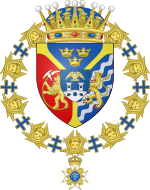 |
1814–1818 | Crown Prince Carl Johan. A modern picture of the coat of arms. |
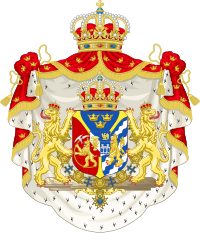 |
1818–1844 | King Charles III John. A modern picture of the coat of arms. |
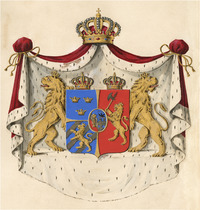 |
1844–1905 | King Oscar I (1844–1859) King Charles IV (1859–1872) |
Since 1814
In 1844, the long halberd (axe) was officially removed, and the shorter axe was brought back. This was the first time an official design was set for the coat of arms. On December 14, 1905, the official design for the royal and government arms was changed again. It went back to the medieval style, with a triangular shield and a more upright lion. The artist Eilif Peterssen created this design.
| Arms | Bearer | Description |
|---|---|---|
 |
King Charles II (ruled 1814–1818) King Charles III John (ruled 1818–1844) |
Not all parts are shown. A modern picture of the coat of arms. |
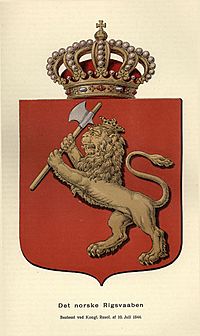 |
King Oscar I (ruled 1844–1859) King Charles IV (ruled 1859–1872) King Oscar II (ruled 1872–1905) |
Official design approved on July 10, 1844. |
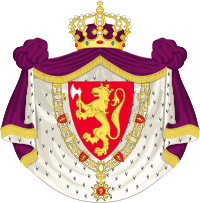 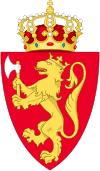 |
King Haakon VII (ruled 1905–1957) King Olav V (ruled 1957–1991) King Harald V (ruled 1991–) |
Design by Eilif Peterssen from December 14, 1905. |
Over hundreds of years, the coat of arms has changed its look many times due to different art styles. In the late Middle Ages, the axe handle became longer and looked more like a halberd. The handle was often curved to fit the shape of the shield or coins of the time.
The coat of arms has also been used by government groups and in other official ways, like on banknotes.
Images for kids
See also
 In Spanish: Escudo de Noruega para niños
In Spanish: Escudo de Noruega para niños
- Norwegian battle axe
- Armorial of Norway
- Armorial of Europe
Literature
- P. Petersen: Historisk-heraldisk Fremstilling af Kongeriget Norges Vaaben, og Sammes Afbildning i Bannere, Flag, Mynter og Sigiller, Christiania 1836
- Gustav Storm: Norges gamle Vaaben, Farver og Flag, Kristiania 1894
- Chr. Brinchmann: Norske konge-sigiller og andre fyrste-sigiller fra middelalderen, Kristiania 1924
- Poul Bredo Grandjean: Det danske Rigsvaaben, Copenhagen 1926
- Hallvard Trætteberg: «Norges statssymboler inntil 1814», Historisk Tidsskrift, Vol. 29 No. 8 and 9, Oslo 1933
- Hallvard Trætteberg: Norges våbenmerker. Norske by- og adelsvåben, published by Kaffe Hag, Oslo 1933
- Hallvard Trætteberg: «Norges krone og våpen», i Festskrift til Francis Bull på 50 årsdagen, Oslo 1937
- Hallvard Trætteberg: «The Coat of Arms of Norway», The American-Scandinavian Review, June 1964
- Hallvard Trætteberg: «Det norske kongevåpen i Gelre-våpenboka», Heraldisk Tidsskrift, Vol 3, No 23 p. 126 ff., Copenhagen 1970-74
- Hallvard Trætteberg: «Norges våpen i engelske kilder i middelalderen», Heraldisk Tidsskrift, Vol 3, No 21 p. 29 ff., Copenhagen 1970-74
- Odd Fjordholm: «Om opphavet til det norske løvevåpen. En historiografisk framstilling». Heraldisk Tidsskrift, p. 31-41, Copenhagen 1984
- Hans Cappelen: Heraldikk på norske frimerker Oslo 1988.
- Harald Nissen: «Det norske kongevåpnet», Heraldisk Tidsskrift, Vol10 No 91, Copenhagen March 2005
- Hans Cappelen: «Norge i 1905: Gammelt riksvåpen og nytt kongevåpen», Heraldisk Tidsskrift, Vol 10 No 94, Copenhagen October 2006
- Tom Sverre Vadholm: «Hellig-Olavs øks som norsk symbol», Heraldisk Tidsskrift, Vol 11, No 102, Copenhagen October 2010, p. 59-82



